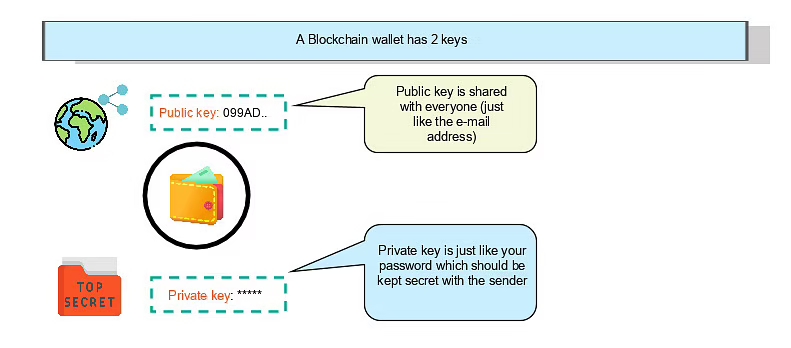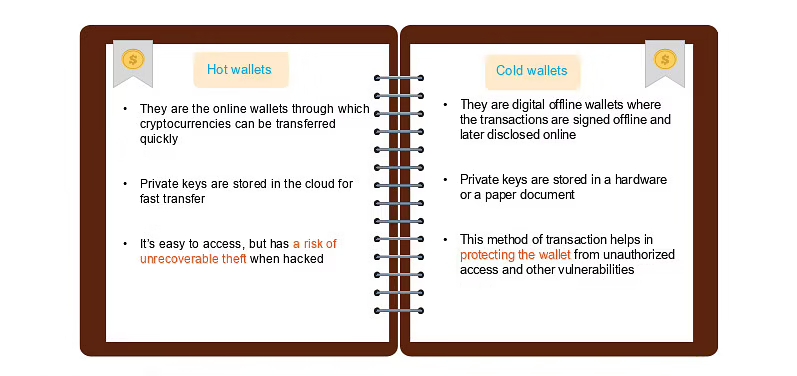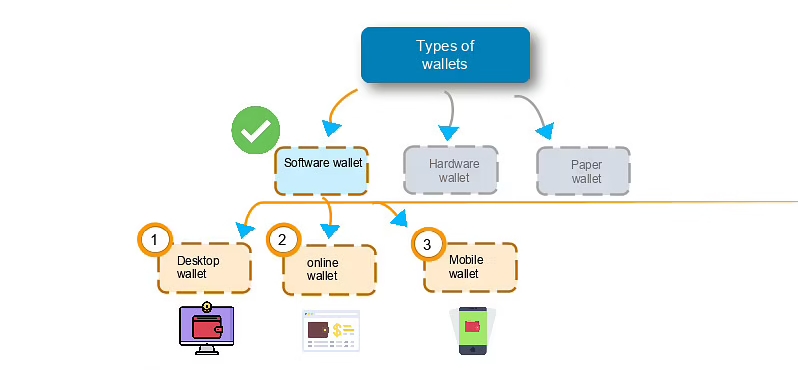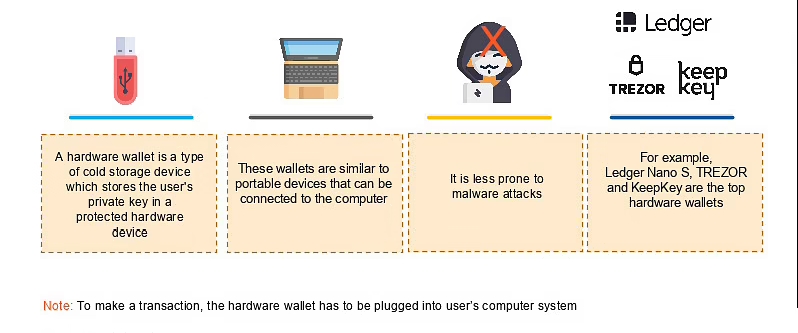Cryptocurrencies such as Bitcoin and Ethereum are becoming increasingly popular due to their many improvements over traditional fiat currencies. If you want to use any of these blockchain-based cryptocurrencies, you’ll need to understand how blockchain wallets work.
The article explains what is blockchain wallet, gives reasons as to why you might use a blockchain wallet and describes the different types of blockchain wallets. It also includes a demo on the use of blockchain wallets.
Why Use a Blockchain Wallet?
Traditional banking systems pose several problems for doing any transaction. For one thing, transactions are often slow. For another, any transaction has to pass through an intermediary, like a bank, meaning there is a central point of failure. And there are issues in keeping track of all accounts and balances; data can get jeopardized, manipulated, or even corrupted across multiple systems where the accounts and balances are maintained. Blockchain wallets reduce or eliminate these problems.
What is a Blockchain Wallet?
A blockchain wallet is a cryptocurrency wallet that allows users to manage different kinds of cryptocurrencies—for example, Bitcoin or Ethereum. A blockchain wallet helps someone exchange funds easily. Transactions are secure, as they are cryptographically signed. The wallet is accessible from web devices, including mobile ones, and the privacy and identity of the user are maintained. So a blockchain wallet provides all the features that are necessary for safe and secure transfers and exchanges of funds between different parties.

It is very similar to the process of sending or receiving money through PayPal or any other gateway used today, but you use cryptocurrency instead. Examples of blockchain wallets include Electrum, Blockchain.info, Jaxx, Mycelium, Samurai, and Bitcoin paper wallet. There are many more based on the needs you have and the security you require.
How Do Blockchain Wallets Work?
First, let’s discuss what private and public keys are and how these keys are related to a blockchain wallet. Whenever you create a blockchain wallet, you are provided a private key and a public key that is associated with your wallet. Let’s use email as an example. If you want to receive an email from someone, you give him or her your email address.
But giving out your email address doesn’t mean someone will be able to send out emails via your account. Someone would have to know your email account’s password to do that. Blockchain wallets follow a similar process using a public key and a private key together. A public key is similar to your email address; you can give it to anyone. When your wallet is generated, a public key is generated, and you can share the public key with anyone in order to receive funds.
The private key is top secret. It’s similar to your password; it should not get hacked and you should not disclose it to anyone. You use this private key to spend your funds. If someone gets access to your private key, there is a high possibility that your account is compromised, and you might end up losing all the cryptocurrency deposits in your account.

Blockchain Wallet Features
Now that you know how Blockchain wallets work, it is imperative that you should know about their features. Here are some of the important features of Blockchain wallets:
- Easy to use. It’s just like any other software or a wallet that you use for your day-to-day transactions.
- Highly secure. It is just a matter of securing your private key.
- Allows instant transactions across geographies. And these are barrier-free, without intermediaries.
- Low transaction fees. The cost of transferring funds is much lower than with traditional banks.
- Allows transactions across multiple cryptocurrencies. This helps you do easy currency conversions.
Blockchain Wallet Types
There are two types of blockchain wallets based on private keys: hot wallets and cold wallets. Hot wallets are like normal wallets that we carry for day-to-day transactions, and these wallets are user-friendly. Cold wallets are similar to a vault; they store cryptocurrencies with a high level of security.
Hot Wallets and Cold Wallets
Hot wallets are online wallets through which cryptocurrencies can be transferred quickly. They are available online. Examples are Coinbase and Blockchain.info. Cold wallets are digital offline wallets where the transactions are signed offline and then disclosed online. They are not maintained in the cloud on the internet; they are maintained offline to have high security. Examples of cold wallets are Trezor and Ledger.
With hot wallets, private keys are stored in the cloud for faster transfer. With cold wallets, private keys are stored in separate hardware that is not connected to the internet or the cloud, or they are stored on a paper document. Hot wallets are easy to access online 24/7 and can be accessed via a desktop or mobile device, but there is the risk of unrecoverable theft if hacked. With cold wallets, the method of the transaction helps in protecting the wallet from unauthorized access (hacking and other online vulnerabilities).

We can further break down wallets into three types:
- Software wallets;
- Hardware wallets, which you plug into your USB drive; and
- Typical paper-based wallets, for which you print your public key and private key on a piece of paper and keep it in a secure place.
Software Wallets
A software wallet is an application that is downloaded on a device; it could be a desktop or a mobile device, or it could be a web-based wallet that can be accessed online. Breadwallet, Jaxx, and Copay are popular software wallets. We can further categorize software wallets as desktop wallets, online wallets (web wallets), and mobile wallets.

Desktop Wallets
Desktop wallets are cold wallets in which the private keys are stored in cold servers (in your desktop). You can unplug the wallet from the Internet, do some offline transactions, and then bring it back online. In case the main server is lost, then a cold server, basically your desktop, is used as a backup server.
These wallets can be downloaded on any computer but can be accessed only from the system they are installed on, so you make sure the desktop or the machine on which you are downloading the desktop wallet is safe (has a backup and is in a secure location), and that you’re maintaining the hardware and not letting the machine go anywhere.
These wallets are definitely cost-efficient. Electrum is one of the most popular desktop wallets.Online Wallets
These are other kinds of hot wallets that run on the Internet. Users have the benefit of accessing these wallets across any device. It could be a tablet or a desktop, or you can access it from your mobile browser. The private keys are stored online and are managed by a third party. For example, GreenAddress is a Bitcoin wallet that is available on the web, has an Android app, is available on a desktop, and also is available on iOS.Mobile Wallets
Mobile wallets are similar to online wallets except that they are built only for mobile phone use and accessibility. These wallets have a user-friendly interface that helps you do transactions easily. Mycelium is the best available mobile wallet.
Hardware Wallets
A hardware wallet is a type of cold storage device, typically like a USB, that stores the user’s private key in a protected hardware device. These wallets are similar to portable devices that can be connected to the computer (plugged in). As noted earlier, they are less prone to malicious attacks and are hack-proof. Ledger, Trezor, and KeepKey are the top hardware wallets on the market.
To make a transaction from your hardware wallet, you have to ensure that the hardware wallet is plugged into your computer system.

Paper Wallets
A paper wallet is an offline process for storing cryptocurrencies. This wallet is a printed paper that has both your private key and public key, which are accessed using a QR code. Since these wallets are safe, they are widely used for storing large amounts of cryptocurrencies. Bitcoin Paper Wallet and MyEtherWallet are two widely used paper wallets.
A paper wallet works with your software wallet to transfer funds from your software wallet to the public address shown on your paper wallet. First, you park your funds in a software wallet, then you transfer the funds from your software wallet to the public address printed on the paper wallet
Blockchain Wallets Comparison
Blockchain.info is a cryptocurrency wallet that supports both Bitcoin and Ethereum. It is easy to use and has a low transaction fee. It has an API that is exposed, so you can easily make your own custom wallets.
Ledger Nano S is a hardware wallet that offers high security for your account. It is available for Bitcoin, Ethereum, and Litecoin. It is also possible to maintain multiple accounts and access them anytime.
Bitcoin paper wallet helps you to print your own tamper-resistant Bitcoin wallet. It minimizes the threat of hacking.
Jaxx enables a user to exchange currencies within the wallet. It is available for Bitcoin, Ethereum, Litecoin, and many other cryptocurrencies. With Jaxx, a user can view his or her updated balance as soon as the processing is complete.
![[Trezor One] Trezor One Hardware Wallet](/web/image/product.template/49132/image_512/%5BTrezor%20One%5D%20Trezor%20One%20Hardware%20Wallet?unique=539c3a4)